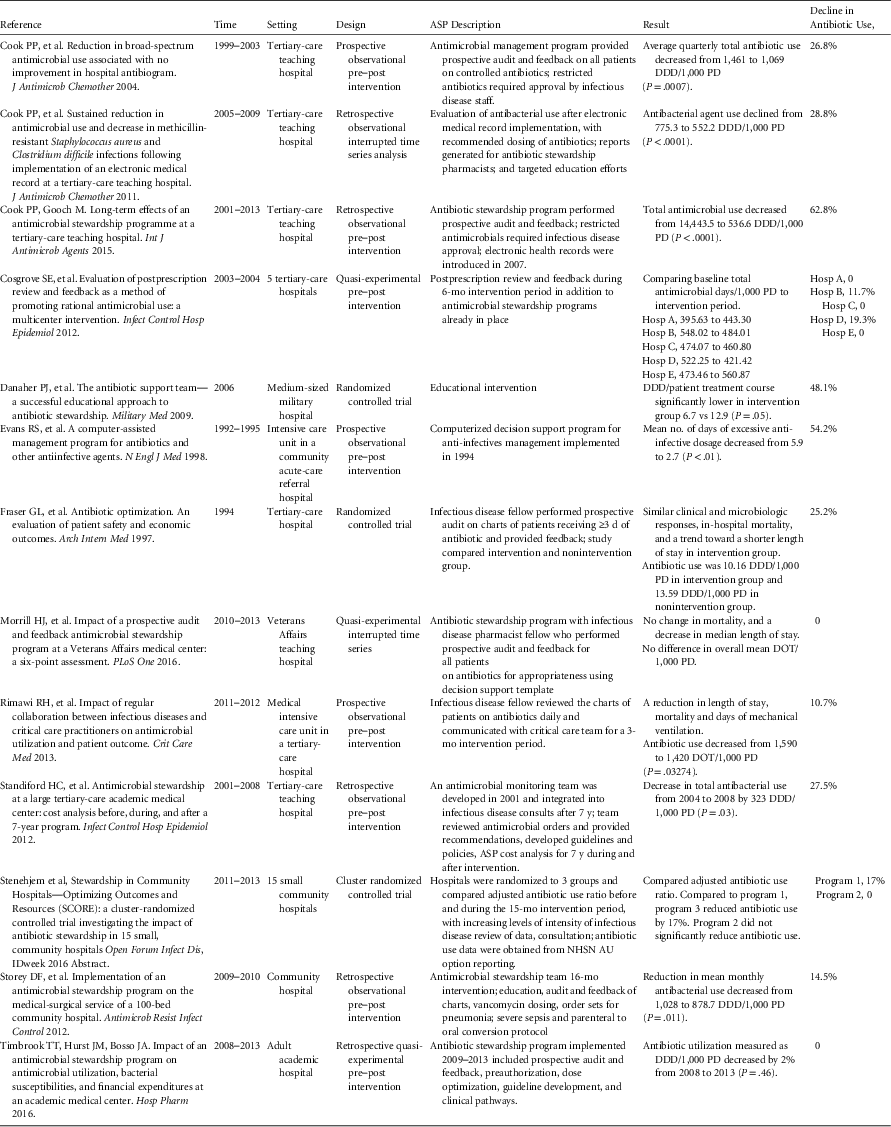To the Editor—We sought to characterize the expected decline in US acute-care antibiotic prescribing resulting from new accreditation standards requiring antibiotic stewardship programs. 1 We conducted a narrative review of published literature assessing the impact of antibiotic stewardship program implementation on total antibiotic prescribing in acute-care hospitals in the United States.
A PubMed search was performed using the following search strategy: antimicrobial OR antibiotic AND stewardship from January 1996 to December 2016. Finally, 12 articles and 1 abstract that reported the effect of antimicrobial stewardship programs on total antibiotic use in adult US acute-care hospitals were included. The median and interquartile range (IQR) of decline in antibiotic use observed with implementation of antibiotic stewardship programs were calculated (Table 1). If no significant decline in antibiotic use was noted, percentage decline was considered to be zero. To quantify the expected national decline in antibiotic use following the implementation of antibiotic stewardship programs, the calculated median and IQR were applied to the 2012 national estimate of adult antibiotic use in acute care hospitals obtained from the Truven Health MarketScan Hospital Drug Database (HDD).Reference Baggs, Fridkin, Pollack, Srinivasan and Jernigan 2
TABLE 1 Published Papers and Abstracts Evaluating Antibiotic Use Changes in Adult Acute Care Hospitals in the United States

NOTE. DDD, defined daily dose; DOT, days of therapy; PD, patient days.
Most studies reported the implementation of “audit and feedback,” with or without antibiotic restriction; 2 studies evaluated the effect of computerized decision support; and 1 study implemented an educational intervention pertaining to the electronic health record. The median decline in antibiotic use was 15.8% (IQR, 0–27.3%). The national estimate of total adult antibiotic use in 2012 in US acute-care hospitals was 103 million days of therapy (DOT) or 817.8 DOT per 1,000 patient days (PD) as reported by the HDD. Widespread implementation of antibiotic stewardship programs would therefore be expected to lead to an estimated median decline of 16 million DOT (IQR, 0–28 million) in total systemic antibiotic use, or a median national target of 688.6 DOT per 1,000 PD in US adult acute-care hospitals.
None of the studies reviewed showed worsening outcomes, such as increased mortality or readmissions, consistent with a recent Cochrane review.Reference Davey, Marwick and Scott 3 Reporting clinical outcomes provides an opportunity to assess the safety and potential benefits of reducing unnecessary antibiotic use. A few studies showed no change or a decrease in Clostridium difficile infection and antibiotic-resistant pathogens, which are important metrics for assessing the patient-level impact of antibiotic stewardship.Reference Moehring, Anderson, Cochran, Hicks, Srinivasan and Dodds Ashley 4
A publication bias toward positive results may lead to the overestimation of the effect of antibiotic stewardship programs. Hospital characteristics and types of interventions varied, as did the approaches to measurement and to reported outcomes. However, with the implementation of antibiotic stewardship programs in adult US acute-care hospitals, an estimated 15.8% (~16 million DOT) of total antibiotic prescribing might be avoided. This number does not include other important improvements that could be made, such as narrowing the spectrum of therapy and shortening postdischarge courses. Hospital stewardship programs should be supported in their efforts to protect patients from preventable harms caused by unnecessary antibiotic exposure.
ACKNOWLEDGMENTS
Financial support: This work was supported by the Centers for Disease Control and Prevention. The findings and conclusions in this report are those of the authors and do not necessarily represent the official position of the Centers for Disease Control and Prevention.
Potential conflicts of interest: All authors report no conflicts of interest relevant to this article.



